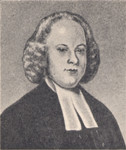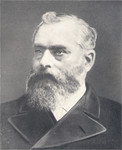|
Up: United Kingdom |
Hayward Brothers Home > Prism Glass > United Kingdom > Hayward |
UK: 4 of 13 |
|
Up: United Kingdom |
Hayward Brothers Home > Prism Glass > United Kingdom > Hayward |
UK: 4 of 13 |
 Fama Semper Vivet Fame Lives Forever
 Albumen print ca 1900: 16" circular floor light —Links—  N' ALLEZ PAS À TATONS DANS L' OBSCURITÉ (Don't grope about in the dark) |
Hayward Brothers has the oldest story in prism glass. The Hayward family had been living in London ("the square mile") for 200 years before Samuel, son of the Rev. Samuel, opened his glass-cutting and glaziers shop at No. 26, Bread Street, off Cheapside, in 1783. Of Samuel's 26 children (by two wives), four sons survived and have a part in this story: John and Samuel by the first, and James and George by the second. John, the eldest, stayed in the business for some years, then went into paint and house decorating; James took up ironmongery; George became a wholesale stationer. It was son Samuel who followed his father's trade and was the direct line to Hayward Brothers.
The sign of The Dog's Head in the Pot, which stood above the corner shop at Number 23, St. George's Place, was the Hayward Brothers trademark: it appeared on bill-headings and advertisements and was embossed on ironwork (see coal plate, left). Said to date from the 16th century and to have once stood over an inn, the sign first appeared over Number 25, Antony Walker's ironmongery shop: ironmongers make both "dogs" and pots. When Walker retired, Thomas Noble (or his successor) bought the sign and moved it to Number 23, which remained an ironmonger's works for the next 160 years until being destroyed in World War II. The sign survived, and lives today in the Cuming Museum. In 2015, a replica was installed at the location of the original shop. Noble vacated the corner shop (renumbered 117 Blackfriars Road) in 1807 and was replaced by William Browne, also an ironmonger. Another ironmonger in this story was George Glover of 117 Union Street (specializing in iron fences). In 1830, Robert Henly appeared on the scene, in business with both Browne and Glover. When Glover retired in 1838, Henly took over entirely. He prospered for another 20 years, eventually expanding 117 Union Street, acquiring 118 and rebuilding them both.
In 1848, Henly, in ill health, sold the business. John, head of the Hayward family, had just died, and brothers Edward and William now chose to depart from their previous line of work and bought Henly's company, forming Hayward Brothers ("late R. Henly & Co"). Their main products were ironwork: ranges, stoves, coal plates, circular and spiral staircases, and ventilators. In 1857, the corner premises on Blackfriars Road were abandoned in favor of Union Street. Shortly after, a new product, iron pavement lights glazed with rough cast glass, were added to the company's line. The lights were popular, and the company successful, but in 1871 Edward's Patent No. 2,014, "Improvements in Pavement Lighting", changed everything. Before then, lighting basements had been problematic. Open gratings let in light, but were open to the weather as well, and hard to stand and walk on; slab glass in iron frames was better, but admitted only a small amount of useful light; triangular glasses had been tried, but were not well designed, and threw most of the incident light back out again. Edward's idea was to split the triangular light in half (his "semi-prism"): now the rays of light entering the top were throw horizontally into the space below, lighting areas deep inside (see diagram right). "Unlike any ordinary reflectors (which become tarnished or covered with dust)", says one catalog, "these retain their brightness, as the reflection comes from inside the body of the glass. Every other description of Pavement Light allows the rays on entering to disperse equally in all directions, so that not quite half of them can possibly radiate inwards." Common sense, a good design, and priced favorably with the older type: business took off. Edward died only five years after his greatest patent, and the company fell to William. Being the younger brother and generally content to take second place, William looked for a new partner. In 1876, William Eckstein, trained as an engineer and tried in the Indian Civil Service, returned to London and fit the bill. He joined Hayward Brothers as manager, then in 1880 was made partner, the company's style becoming Hayward Brothers & Eckstein. William, the last Hayward involved in the company, retired in 1891, but Eckstein continued the company with the well-known Hayward name, with J. A. Willmore joining that year as the new partner. In 1896, the partnership was turned into a limited liability company called Haywards Limited, under which name it continued until the 1970s. Years of Reflection 1783-1953. |
 Rev. Samuel  Edward Hayward  William Hayward  William Eckstein  Semi-Prism Pavement Light |
 |
 |
 |
||
| Hayward's Patent "Semi-Prism" Pavement Lights Hayward Brothers & Eckstein, London GB, ca.1885, 36p Rakow Research Library, Corning Museum of Glass ~20MB: pdf |
Hayward Brothers & Eckstein Catalogue—Section I London GB, ca.1900, 76p JPG ~155MB: tar zip pdf |
Scribbling Diary for 1906 Hayward Brothers & Eckstein, Ltd London GB, 1906, 102p JPG ~265MB: tar zip pdf Donated to Rakow |
 |
 |
 |
||
| Hayward's Pavement Lights Haywards Ltd, London GB, ca.1920, 60p Pages 2-61 (cover missing) JPG ~109MB: tar zip pdf PNG ~345MB: tar zip pdf Donated to Rakow |
Haywards Pavement Lights Haywards Ltd, London GB, 1929, 111p JPG ~238MB: tar zip pdf PNG ~1.6GB: tar zip Donated to Rakow |
Years of Reflection 1783-1953 Haywards Ltd London GB, 1953, 112p JPG ~113MB: tar zip pdf PNG ~613MB: tar zip |